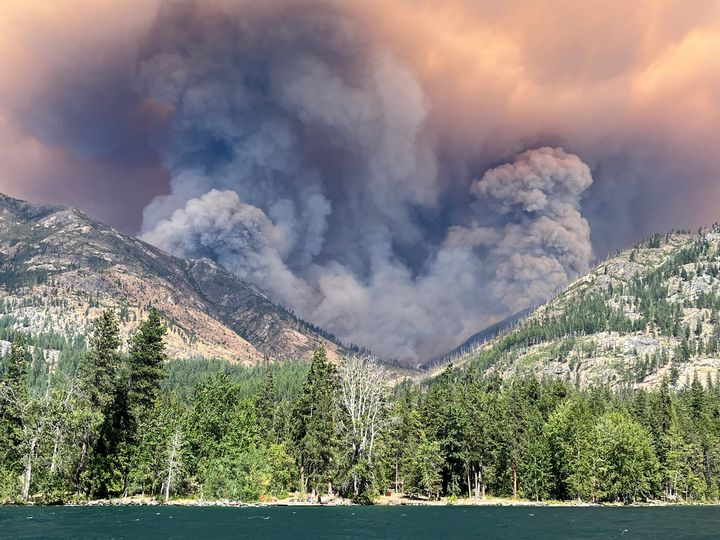
Washington deals with peak fire season conditions, state agencies ready to respond
Read
Everyone watching fires around Washington this week held their breath as about 600 lightning strikes hit the landscape across the state.
The Washington State Department of Natural Resources, who, alongside agency partners, prepared for those conditions this week by pulling in out-of-state resources and prepositioning crews. The lightning strikes ignited at least two fires in the state, the Easy fire and Swawilla fire. According to a public information officer on the Swawilla fire, a series of fires started from lightning strikes on the Colville Reservation this week.
Now and through the weekend, firefighters will be tracking other starts from the lightning strikes, said Matthew Dehr, lead wildland fire meteorologist with the DNR, during a press briefing Thursday.
Already, the state has had over 400 fires, Commissioner of Public Lands Hilary Franz said in Thursday’s press briefing.
The hot, dry and windy weather has amplified fire danger.
“August is typically our peak season, it seems like it’s extended into July for this year, so conditions out there are peak season right now,” Dehr said. “It really is an all-hands-on-deck scenario.”
There are at least nine fires burning on the landscape in the state, and four of those are considered large, according to DNR.
One fire, the Pioneer fire in Chelan County, continues to pose challenges to crews as it burns in steep, rugged and remote terrain. Franz said personnel and equipment are having to be brought in by air and boat.
That fire is serving as sort of a barometer for what can happen on the landscape this season, Dehr said. While it started burning in low-lying fuels, the Pioneer fire has climbed and is burning forested areas at 5,000 feet above sea level.
During the briefing, Franz spoke about the preparedness of the DNR and agency partners to respond to fires this season. Crews are able to get to a fire start in 15 to 30 minutes, she said, allowing them to suppress and quickly move on to the next one. DNR has about 1,300 staff who are trained and available for wildland firefighting.
“We have strategically staged all those resources throughout the state, and have been able to successfully fulfill our orders for resources on the incidents that we’re seeing on the ground in Washington,” said Ryan Rodruck, wildfire communications manager for the DNR.
As of Friday afternoon, Washington is at preparedness level three, meaning the state has the available resources to fight any fires currently burning, and that the state can also handle any new fire that might emerge on the landscape.
Leaving state bounds, however, things become tighter. The Northwest as a whole is at a preparedness level 5. The U.S. is also at a preparedness level 5. That means national resources are heavily committed.
That has some people on the scene at fires feeling the pressure.
The Cougar Creek fire burning in Asotin County is a fast-moving grass fire. It has consumed nearly 5,000 acres. Those types of fires need more resources to try and suppress the blaze before it spreads, because they can move quickly.
“We’re kind of getting stretched thin on the number of resources available,” said Erin Phillips, a public information officer on the scene. “But as priority shifts, we get more resources.”
Both Franz and Dehr spoke about how resources can quickly be overwhelmed, especially when weather conditions make fires all the more possible.
Weather aside, nearly all fires this year have been caused by humans. The DNR put in place a burn ban for public lands that will last at least through September. Respecting burn bans and being cautious about things, such as chains dragging under vehicles that could cause a spark or a lit cigarette hitting dry grass, are all crucial to ensuring no man-made fires happen.
Franz reminded the press during Thursday’s briefing of a milestone birthday this year that gives another reason to remember fire safety.
“It’s Smokey Bear’s 80th birthday,” Franz said. “Probably the best birthday we could give him is actually bringing that 90% of our fires caused by humans down to 10%, and he would be grateful!”
The agency remains confident about its preparedness to tackle whatever happens the rest of the season.
“I’m fully confident that we have the resources right now to address any of the fires that we have on the ground and any potentially emerging new fires,” Rodruck said.
This weekend, more of the same is expected for weather statewide as some parts of Washington could get record-breaking heat, with the Tri-Cities possibly getting up to 110 degrees.
Next week, Dehr said he expects more thunderstorms Monday. Windy conditions will continue in the early part of the week. Temperatures might begin cooling down as the week progresses, a welcome reprieve for all.















